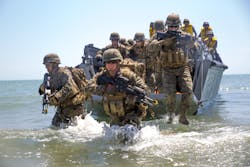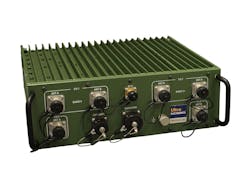Navy chooses tactical radio system from Ultra Electronics for ship-to-shore communications with U.S. Marines
SAN DIEGO – U.S. Navy ship-to-shore communications experts needed line-of-sight tactical radio systems for Navy and U.S. Marine Corps amphibious command and control. They found their solution from the Ultra Electronics TCS segment in Montreal.
Officials of the Naval Information Warfare Systems Command (INFOWAR) in San Diego announced a potential $145.4 million contract to Ultra TCS on Thursday for the Amphibious Tactical Communications Systems (ATCS).
ATCS is based on the Ultra Orion X500 radio, and will provide line-of-sight shipboard systems in support of amphibious command, control, communications, computers and intelligence.
ATCS supports reliable, high-capacity terrestrial, ship-to-ship and ship-to-shore voice, data and video communications, Navy officials say.
ATCS is composed of a radio, power amplifiers, antennas, and other equipment, and will replace the U.S. Navy's legacy AN/SRC-57 digital wideband transmission system and the Marine Corps AN/MRC-142B radio terminal, which are line-of-sight tactical radio relay shipboard and shore-based communications systems.
The ATCS will feature features base stations supported by a virtualized core network, a 30-foot deployable mast, and a 60-inch wide tactical trailer that is internally transportable in a MV-22 Osprey tiltrotor aircraft.
These radios will provide two separate LTE wireless networks -- one for high-capacity network traffic, and one for smart phones, tablet computers, and command post support.
Two years ago Navy INFOWAR proposed a sole-source ATCS contract to Ultra TCS for 73 ATCS systems, consisting of 49 Navy and 24 Marine Corps systems. That proposed sole-source contract also called for spare parts and engineering services.
Ultra TCS is the original equipment manufacturer of the Navy AN/SRC-57 and the Marine Corps AN/MRC-142B and AN/MRC-142C radios that ATCS will replace, is the only source able to provide an interoperable replacement radio without incurring substantial duplication costs, Navy officials say.
The Ultra TCS X500 communications system consists of high-capacity, multi-mission, multi-channel radios that offer throughput of as much as 1 gigabit per second.
These radios can support two point-to-point links or a mix of point-to-point, point-to-multipoint, and mesh network links for a total of two software-defined radio channels, with a secure 802.11 or LTE access channel.
Each X500 channel can be encrypted internally or use an external encryption device. The radios operate in L-band, S-band, C-band, and NII/ISM frequency bands as well as in selected LTE cell phone bands.
Related: Navy looks to General Dynamics for shipboard communications radios
These radios can operate simultaneously in several bands over many waveforms, electronic counter-countermeasures (ECCM) protection, and jamming resilience. They feature secure graphical user interfaces, MIMO technology, and ruggedized enclosures that meet MIL-STD-810G/461F and IP67 industry standards.
On this contract Ultra TCS will do the work in Montreal, and should be finished by July 2030. With options, work could continue through July 2030.
For more information contact Ultra TCS online at www.ultra-tcs.com, or Navy INFOWAR at www.public.navy.mil/navwar/Pages/default.aspx.

John Keller | Editor-in-Chief
John Keller is the Editor-in-Chief, Military & Aerospace Electronics Magazine--provides extensive coverage and analysis of enabling electronics and optoelectronic technologies in military, space and commercial aviation applications. John has been a member of the Military & Aerospace Electronics staff since 1989 and chief editor since 1995.


